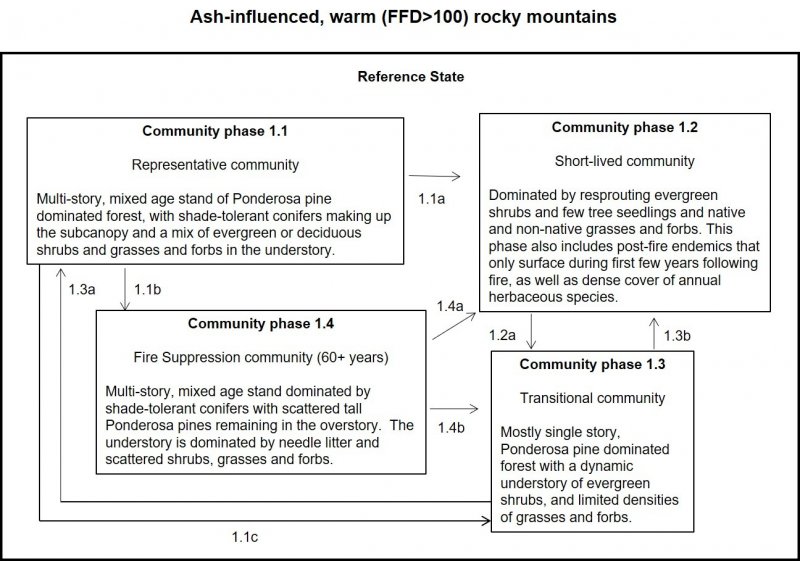Ecological site group F022BF201CA
Ash-Influenced, warm (FFD >100) rocky mountains
Last updated: 03/01/2021
Accessed: 12/21/2025
Ecological site group description
Key Characteristics
None specified
Provisional. A provisional ecological site description has undergone quality control and quality assurance review. It contains a working state and transition model and enough information to identify the ecological site.
Physiography
This ESG is found on mountain summits, backslopes, and shoulders at elevations from 3000 to 5000 feet and slopes typically between 10 to 50%.
Climate
The average annual precipitation in this MLRA is typically 20 to 65 inches but can range from 13 to 123 inches (176 to 2,471 millimeters). This ESG averages 50 inches. It is lowest in the lower valleys and highest on the mountain peaks. The precipitation falls mainly from fall to spring, mostly as snow. Winter precipitation is from Pacific storms that are frontal in nature. The amount of precipitation decreases from west to east. Summers are typically warm and dry, but there are occasional thunderstorms. The average annual temperature is 27 to 61 degrees F (-3 to 16 degrees C). The frost-free period for this ESG is generally less than 100 days, and the freeze-free period averages 215 days and ranges from 85 to 350 days. The lowest annual temperatures and the shortest freeze-free periods occur in the mountains.
Soil features
This ESG is currently represented by:
Parent material: Residuum weathered from rhyolite
Surface textures: gravelly and stony sandy loams
Surface RF%: 15.0 percent (greater than 15% gravels, cobbles and stones)
Depth to restrictive feature: 20 to 24 inches to lithic bedrock
Natural drainage class: Somewhat excessively drained
Runoff class: Medium
Available water storage in profile: Very low (about 2.1-2.8 inches)
HSG: B
Representative soils are Jiggs and Lyonsville components, which are a medial Typic Vitrandepts and Typic Haploxeralfs respectively. And the mapunits include survey CA645 LvD, LvE, LyD and LyE and survey CA607 LhE.
Vegetation dynamics
This site is composed of a lot of map units from a very old soil survey and will likely need to be re-evaluated to determine finer level ecological site concepts within it. It is described as a sloping to steeply sloping site that is excessively drained with a fractured and somewhat weathered rhyolite bedrock. Soils are erosive and can be heavily disturbed by logging practices. Steeper slopes are a high risk of erosion and soil surface loss. Vegetation dominating this site is Ponderosa pine, Douglas-fir and incense cedar.
Across mountain ranges, successional advancement was slower in the drier mountain ranges. In many fire-excluded areas, ponderosa pine and other early-seral, shade-intolerant tree species have been replaced successionally by late-seral, shade-tolerant species. Stand structure has changed from a mostly single canopy layer to multiple canopy layers.
The ponderosa pine habitat includes pure stands of ponderosa pine as well as stands of mixed species in which at least 50% of the canopy area is ponderosa pine. Associated species vary depending on location in the state and site conditions. Typical tree associates include white fir, incense-cedar, Coulter pine, Jeffrey pine, sugar pine, Douglas-fir, canyon live oak, California black oak, Oregon white oak, Pacific madrone and tanoak.
Associated shrubs include manzanita, ceanothus, mountain-misery, Pacific dogwood, hairy yerba-santa, yellowleaf silktassel, bitter cherry, California buckthorn, poison-oak, Sierra gooseberry. Grasses and forbs include slimleaf brome, Orcutt brome, carex, smallflower melicgrass, bluegrass, bottlebrush squirreltail, bedstraw, bracken fern, bush morning-glory, rhomboid clarkia, Child's blue-eyed mary, shrubby eriastrum, splendid gilia, Sierra iris, whisker-brush, Inyo bush lupine, summer lupine, purple nightshade, streptanthus, gooseroot violet, and wild iris.
Montane chaparral species are common post-disturbance on these deeper forest soils. After disturbance (logging, fire, erosion) chaparral proliferates and may exclude conifers and other vegetation for many years. However, chaparral may facilitate the germination of red fir seedlings and other shade tolerant conifers by providing a protective cover, moderating microclimate, and improving soil conditions. Chaparral shrubs may be an essential link in forest succession by building up soil nutrient levels, especially nitrogen, to the point where trees can survive. In mature timber stands, chaparral species may senesce due to insufficient light through the canopy and are only present as a sparse understory. Thus, silvicultural practices have a strong influence on the structure of montane chaparral.
FEIS. Pacific Ponderosa Pine, https://www.fs.fed.us/database/feis/plants/tree/pinponp/all.html. Accessed September 28, 2020.
California Wildlife Habitat Relationships System
California Department of Fish and Game
California Interagency Wildlife Task Group
E. Lee Fitzhugh
Major Land Resource Area
MLRA 022B
Southern Cascade Mountains
Stage
Provisional
Click on box and path labels to scroll to the respective text.

